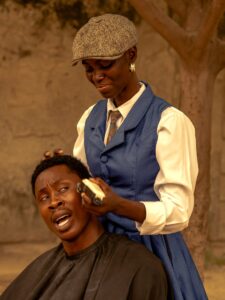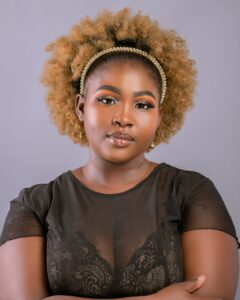Fixing a Bad Haircut: Common Mistakes & Solutions for Curly Hair
At Cameo College, we understand that dealing with a bad haircut can be a daunting experience, especially when it involves the unique challenges of curly hair. Curly hair requires a special touch and understanding of its distinctive texture and curl pattern to achieve a hairstyle that enhances your natural beauty. Whether you’re a prospective student interested in mastering the art of hairdressing or simply someone who has faced the frustration of a bad cut, our guide aims to provide insights into common mistakes and effective solutions to ensure every haircut becomes a positive experience.
Understanding Common Mistakes in Haircuts

Photo by Ario Stories on Pexels
Cutting curly hair demands an appreciation of how different hair types react to various styles and techniques. A common mistake often made by stylists is treating curly hair as they would straight hair, ignoring its unique volume and texture. This oversight can lead to a haircut that disrupts the natural curl pattern, resulting in a style that appears uneven or lacks shape. At Cameo College, we educate our students about the importance of recognizing these differences to avoid a haircutting disaster. Understanding the nuances of curly hair is the first step toward achieving a harmonious and flattering overall look.
Identifying Bad Haircut Signs
When you’ve had a bad haircut, certain signs are often immediately apparent. For curly hair, a bad cut might manifest as uneven curls, sections of hair that don’t blend well, or a fringe that doesn’t sit right. These issues can make your hair appear thin or disrupt the natural flow of your curls. Identifying these signs early on can help in taking corrective measures. Our hairstylist training program focuses on teaching students how to spot these indicators and apply techniques to fix your hair effectively.
Common Missteps When Cutting Curly Hair
One of the most frequent errors made when cutting curly hair is not considering its dry state, as wet hair can appear longer and lead to unexpected results once it dries. Additionally, cutting too much length or creating layers that don’t complement the curl pattern can lead to an undesirable style. These common mistakes result from a lack of understanding of the hair’s natural growth and texture. At Cameo College, we emphasize the importance of personalized haircutting approaches that respect each client’s unique hair type and desired style.
How to Avoid Mistakes with Different Hair Types
To prevent mistakes when cutting different hair types, it is crucial to tailor techniques to the specific needs of each client. For curly hair, this means considering the curl pattern, hair texture, and overall hairstyle goals. Students at Cameo College learn to approach each haircut with an individualized strategy, taking into account factors like face shape and desired length. By applying these principles, our aspiring stylists can transform a potentially bad haircut into a flattering and well-executed style that enhances the client’s natural beauty.
Solutions for Dealing with a Bad Haircut

Photo by Bruno Thethe on Pexels
Techniques to Fix a Bad Haircut
When you’re faced with a bad haircut, especially with curly hair, there are several techniques you can employ to remedy the situation. At Cameo College, we teach our students how to assess the existing style and make strategic adjustments to restore balance and shape. A common approach is to carefully trim uneven sections of hair, ensuring that the curl pattern remains intact. Incorporating hair extensions can also be a temporary fix, adding volume and length while your natural hair grows back. Additionally, clip-in extensions provide a versatile option for those looking to experiment with different hairstyles without a long-term commitment. Understanding these techniques allows our aspiring hairstylists to transform a bad cut into a good haircut, enhancing the client’s overall look.
Choosing the Right Hairstyle for Curly Hair
Selecting the right hairstyle for curly hair involves more than just following trends; it requires an in-depth understanding of curly hair’s unique characteristics. At Cameo College, our curriculum emphasizes the importance of considering factors such as face shape, curl pattern, and hair texture when recommending a style. For instance, a layered haircut can add dimension and reduce bulk, while well-placed bangs can frame the face beautifully. We encourage our students to collaborate with clients, discussing their lifestyle and personal preferences to ensure the chosen style not only suits their appearance but also their daily routine. This personalized approach empowers our students to deliver a haircut that complements the natural beauty of curly hair.
When to Consult a New Stylist
Sometimes, dealing with a bad haircut may involve seeking a new hairstylist. Knowing when to make this decision can save you from further frustration. At Cameo College, we educate our students on the importance of building trust and communication with clients. If a stylist repeatedly fails to understand your hair type or deliver your desired style, it might be time to explore other options. Look for a hairstylist who specializes in curly hair and is receptive to feedback, ensuring they are aligned with your hair care goals. A good stylist will not only fix your hair but will also offer guidance on hair care techniques and products that promote healthy hair growth. This proactive approach ensures that each haircut is a positive and fulfilling experience.
Styling Options for Curly Hair After a Bad Cut

Photo by directorvinny studios on Pexels
Using Hair Accessories to Enhance Your Look
When dealing with a bad haircut, especially for those with curly hair, using hair accessories can be a lifesaver. These accessories not only add flair to your hairstyle but also help in managing sections of hair that may not sit perfectly due to an uneven cut. Headbands, scarves, and decorative clips can enhance your overall look while camouflaging any imperfections. At Cameo College, we teach our students to creatively use hair accessories to complement the natural curl pattern and texture. By strategically placing these items, you can draw attention to your best features and away from the areas affected by a bad cut. This approach allows individuals to express their personal style while their hair grows back.
Tips for Embracing Your Natural Texture
Embracing your natural hair texture is an empowering way to deal with a bad haircut. Understanding and working with your curl pattern rather than against it can transform your perspective on hairstyling. At Cameo College, we encourage students to educate clients about the beauty and versatility of their natural curls. Techniques such as diffusing to enhance volume and using curl-defining products can make a significant difference. By focusing on enhancing the natural texture, individuals can create a unique and personalized hairstyle that celebrates their curls. This not only boosts confidence but also reduces the need for frequent salon visits to fix your hair, making it a practical and rewarding choice.
Letting It Grow: Managing Hair Growth After a Cut
After experiencing a bad cut, letting your hair grow back is a common solution, but it requires patience and proper management. At Cameo College, we emphasize the importance of understanding hair growth cycles and practicing effective hair care to promote healthy growth. Regular trims are crucial to prevent split ends and maintain a good haircut as your hair grows. We advise using hair growth products that nourish the scalp and support the hair’s natural growth. Additionally, protecting your hair from environmental damage and minimizing heat styling can preserve its health. By educating students on these practices, we ensure they can guide clients in managing their hair growth journey effectively, leading to a satisfying and stylish outcome.
Preventative Measures for Future Haircuts

Photo by Brett Jordan on Unsplash
What to Communicate with Your Hairdresser
Effective communication with your hairdresser is crucial to avoid a bad haircut, especially when dealing with curly hair. At Cameo College, we teach our students to encourage clients to express their hairstyle goals clearly and to discuss any past hairdressing experiences that might influence their current preferences. Sharing details about the desired length, layers, and how you typically style your hair can guide the hairstylist in making informed decisions. Mentioning your hair texture and curl pattern can help the stylist understand the intricacies involved in achieving a good haircut. A detailed consultation helps establish a mutual understanding, reducing the risk of common mistakes and ensuring that the next haircut aligns with your vision and natural beauty.
Researching New Haircut Styles Before Visiting a Salon
Before visiting a salon, researching new haircut styles tailored to your curly hair can make a significant difference. Familiarizing yourself with various styles that suit your curl pattern and face shape helps in making informed decisions. At Cameo College, we guide students in advising clients to gather visual references from magazines or online platforms showcasing desired hairstyles. Understanding the latest trends and how they can be adapted for curly hair is essential. This preparatory step ensures that you and your stylist are on the same page, minimizing the chances of a bad haircut. By actively participating in the styling process, you can achieve a hairstyle that complements your natural features and personal style.
Maintaining Healthy Curls After a Bad Haircut
Maintaining healthy curls after experiencing a bad haircut involves a combination of proper hair care and styling techniques. At Cameo College, we emphasize the importance of nurturing your hair to encourage growth and restore its natural vitality. Regular conditioning treatments and the use of curl-enhancing products can help in revitalizing your curls. Avoiding excessive heat styling and opting for protective hairstyles can prevent further damage. Our students learn to advise clients on gentle detangling methods and the importance of using wide-tooth combs to maintain curl integrity. By implementing these practices, you can manage your hair’s health and appearance as it grows back, eventually achieving the desired style.

